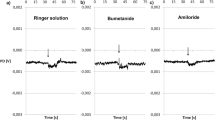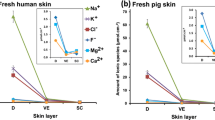Summary
In studies of apical membrane current-voltage relationships, in order to avoid laborious intracellular microelectrode techniques, tight epithelia are commonly exposed to high serosal K concentrations. This approach depends on the assumptions that high serosal K reduces the basolateral membrane resistance and potential to insignificantly low levels, so that transepithelial values can be attributed to the apical membrane. We have here examined the validity of these assumptions in frog skins (Rana pipiens pipiens). The skins were equilibrated in NaCl Ringer's solutions, with transepithelial voltageV t clamped (except for brief perturbations ΔV t) at zero. The skins were impaled from the outer surface with 1.5m KCl-filled microelectrodes (R el>30 MΩ). The transepithelial (short-circuit) currentl i and conductanceg t=−ΔI t/ΔV t, the outer membrane voltageV o (apical reference) and voltage-divider ratio (F o=ΔV o/ΔV t), and the microelectrode resistanceR el were recorded continuously. Intermittent brief apical exposure to 20 μm amiloride permitted estimation of cellular (c) and paracellular (p) currents and conductances. The basolateral (inner) membrane conductance was estimated by two independent means: either from values ofg i andF o before and after amiloride or as the ratio of changes (−ΔI c/ΔV i) induced by amiloride. On serosal substitution of Na by K, within about 10 min,I c declined andg t increased markedly, mainly as a consequence of increase ing p. The basolateral membrane voltage (V i(=−V o) was depolarized from 75±4 to 2±1 mV [mean±sem (n=6)], and was partially repolarized following amiloride to 5±2 mV. The basolateral conductance increased in high serosal K, as estimated by both methods. Essentially complete depolarization of the basolateral membrane and increase in its conductance in response to high [K] were obtained also when the main serosal anion was SO4 or NO3 instead of Cl. On clampingV t over the range 0 to +125 mV in K2SO4-depolarized skins, the quasi-steady-stateV o V t relationship was linear, with a mean slope of 0.88±0.03. The above results demonstrate that, in a variety of conditions, exposure to high serosal K results in essentially complete depolarization of the basolateral membrane and a large increase in its conductance.
Similar content being viewed by others
References
Armstrong, W. McD., Garcia-Diaz, J.F. 1981. Criteria for the Use of Microelectrodes to Measure Membrane Potentials in Epithelia Cells. Epithelial Ion and Water Transport. A.D.C. Macknight and J.F. Leader, editors. Raven, New York
Benos, D.J., Hyde, B.A., Latorre, R. 1983. Sodium flux ratio through the amiloride-sensitive entry pathway in frog skin.J. Physiol. (London) 81:667–685
Boulpaep, E.L., Sackin, H. 1980. Electrical analysis of intraepithelial barriers.Curr. Top. Membr. Transp. 13:169–197
DeLong, J., Civan, M.M. 1984. Apical sodium entry in split frog skin: Current voltage relationship.J. Membrane Biol. 82:25–40
Essig, A. 1982. Influence of cellular and paracellular conductance patterns on epithelial transport and metabolism.Biophys. J. 389:143–152
Fuchs, W., Hviid Larsen, E., Lindemann, B. 1977. Current-voltage curve of sodium channels and concentration dependence of sodium permeability in frog skin.J. Physiol. (London) 267:137–166
Frömter, E., Gebler, B. 1977. Electrical properties of amphibian urinary bladder epithelia. III. The cell membrane resistances and the effect of amiloride.Pfluegers. Arch. 371:99–108
Garcia-Diaz, J.F., Baxendale, L.M., Klemperer, G., Essig, A. 1985. Cell K activity in frog skin in the presence and absence of cell current.J. Membrane Biol. 85:143–158
Klemperer, G., Garcia-Diaz, J.F., Essig, A. 1984. Effects of high serosal K concentration on electrophysiological parameters of frog skin.J. Gen. Physiol. 84:29a
Koefoed-Johnsen, V., Ussing, H.H. 1958. The nature of the frog skin potential.Acta Physiol. Scand. 48:298–308
Lewis, S.A., Butt, A.G., Bowler, J.M., Leader, J.P., Macknight, A.D.C. 1985. Effect of anions on cellular volume and transepithelial Na+ transport across toad urinary bladder.J. Membrane Biol. 83:119–137
Lewis, S.A., Wills, N.K., Eaton, D.C. 1978. Basolateral membrane potential of a tight epithelium: Ionic diffusion and electrogenic pump.J. Membrane Biol. 41:117–148
Li, J.H.-Y., Palmer, L.G., Edelman, I.S., Lindemann, B. 1982. The role of sodium-channel density in the natriferic response of the toad urinary bladder to an antidiuretic hormone.J. Membrane Biol. 64:77–89
Lindemann, B., Van Driessche, W. 1977. Sodium specific membrane channels of frog skin and pores: Current fluctuations reveal high turnover.Science 195:292–294
MacRobbie, A.C., Ussing, H.H. 1961. Osmotic behavior of the epithelial cells of frog skin.Acta Physiol. Scand. 53:348–365
Nagel, W. 1976. The intracellular electrical potential of the frog skin epithelium.Pfluegers Arch. 365:135–143
Nagel, W. 1977. Effects of high [K] upon the frog skin intracellular potentials.Pfluegers Arch. 368:R22
Nagel, W. 1978. Effects of antidiuretic hormone upon electrical potential and resistance of apical and basolateral membranes of frog skin.J. Membrane Biol. 42:99–122
Nagel, W. 1980. Rheogenic sodium transport in tight epithelium: the amphibian skin.J. Physiol. (London) 302:281–295
Nagel, W. 1985. Basolateral Ionic Conductance In Frog Skin.Pfluegers Arch. 405 (Suppl. 1):539–543
Nagel, W., Garcia-Diaz, J.F., Essig, A. 1983. Contribution of junctional conductance to the cellular voltage-divider ratio in frog skins.Pfluegers Arch. 399:336–341
Palmer, L.G. 1982a. Na+ transport and flux ratio through apical Na+ channels in toad bladder.Nature (London) 297:688–690
Palmer, L.G. 1982b. Ion selectivity of the apical membrane Na channel in the toad urinary bladder.J. Membrane Biol. 67:91–98
Palmer, L.G. 1984. Use of potassium depolarization to study apical transport properties in epithelia.Curr. Top. Membr. Transp. 20:105–121
Palmer, L.G., Edelman, I.S., Lindemann, B. 1980. Current-voltage analysis of apical sodium in toad urinary bladder: Effects of inhibitors of transport and metabolism.J. Membrane Biol. 57:59–71
Palmer, L.G., Li, J.H.-Y., Lindemann, B., Edelmann, I.S. 1982. Aldosterone control of the density of sodium channels in the toad urinary bladder.J. Membrane Biol. 64:91–102
Rick, R., Roloff, C., Dörge, A., Beck, F.X., Thurau, K. 1984. Intracellular electrolyte concentrations in the frog skin epithelium: Effect of vasopressin and dependence on the Na concentration in the bathing media.J. Membrane Biol. 78:129–145
Robinson, R.A., Stokes, R.H. 1968. Electrolyte Solutions. Butterworth, London
Share, L., Ussing, H.H. 1965. Effect of potassium on the movement of water across the isolated amphibian skin.Acta Physiol. Scand. 64:109–118
Tang, J., Helman, S.I. 1983. Electrical parameters of apical and basolateral membranes ofR. pipiens depolarized by 100 mM [K].Fed Proc. 42:1101
Thompson, S.M., Suzuki, Y., Schultz, S.G. 1982. The electrophysiology of rabbit descending colon: II. Current-voltage relations of the apical membrane, the basolateral membrane, and the parallel pathways.J. Membrane Biol. 66:55–61
Turnheim, K., Thompson, S.M., Schultz, S.G. 1983. Relation between intracellular sodium and active sodium transport in rabbit colon: Current-voltage relations of the apical sodium entry mechanisms in the presence of varying luminal sodium concentration.J. Membrane Biol. 76:299–309
Ussing, H.H., Biber, T.U.L., Bricker, N.S. 1965. Exposure of the isolated frog skin to high potassium concentrations at the internal surface. II. Changes in epithelial cell volume, resistance, and response to antidiuretic hormone.J. Gen. Physiol. 48:425–433
Varanda, W.A., Lacaz Vieira, F. 1978. Transients in toad skin: Short circuit current and ionic fluxes related to inner sodium substitution by monovalent cations.J. Membrane Biol. 39:369–385
Author information
Authors and Affiliations
Rights and permissions
About this article
Cite this article
Klemperer, G., Garcia-Diaz, J.F., Nagel, W. et al. Basolateral membrane potential and conductance in frog skin exposed to high serosal potassium. J. Membrain Biol. 90, 89–96 (1986). https://doi.org/10.1007/BF01869688
Received:
Revised:
Issue Date:
DOI: https://doi.org/10.1007/BF01869688




